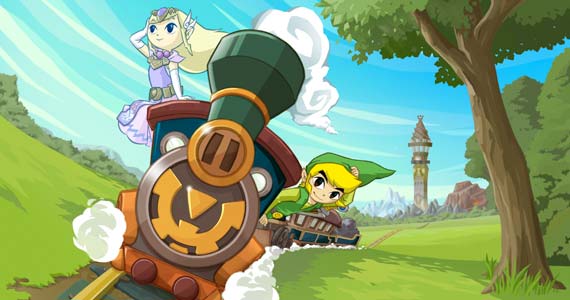
My first GDC glimpse of Link traveling into view aboard a train provoked a knee-jerk reaction that caused the word “gimmicky” to slip passed my lips. And though the impulse was earnest, it was a poor descriptor considering that the industry is at least 90% gimmick, with the remaining 10% left to fight it out between inspiration and other mysterious elements.
It was also an inadequate word to describe the way Nintendo is altering the legacy earned by The Legend of Zelda to date, which isn’t changing simply because new installments involve different modes of transportation in Hyrule, but because the emphasis on that concern shifts the entirety of the experience along with the significance of one of the industry’s most treasured franchises.
But let’s start out on a more solid footing by restating the obvious and acknowledge that The Legend of Zelda is the industry’s example of the oldest story in our possession. For the most part, each new entry to the series is a retelling of the hero’s story, told to new generations with subtle variations regarding the how and why to represent evolving sensibilities and ideas, but always anchored by a idealized image of human development. Though Spirit Tracks deviates with a more specific attempt at placing itself within a timeline, the game still takes advantage of the formula that furnishes the series with this reputation, failing to recognize the burden of responsibility and expectation the brand carries.
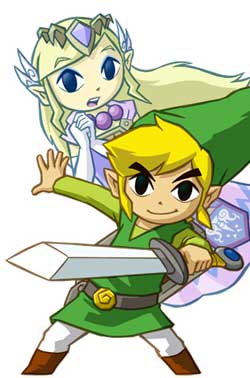
The act of stepping into the larger role of a hero is intimately tied to also recognizing one’s self as part of a larger world where those first footsteps are to be placed. Subsequently, the Zelda narrative formula necessitates a large cast of characters, spread across Hyrule to meet Link along his quest, representing any number of ideas and themes as the storyteller at the time pleases. These characters expand the scope of Hyrule’s narrative by their place within it, which affects Link’s connection to that world and thus his motivation toward personal growth and development in saving it.
How Link went about traversing this landscape was always an interesting consideration, but certainly not the primary focus. And yet within Spirit Tracks it clearly is, having found a formula within Windwaker that mutates to function as a primary narrative device. Nintendo has weaved these tracks into the stitching that holds the big book of Zelda together with skill, but left more than a few loose threads in the greater legacy of the series for the effort.
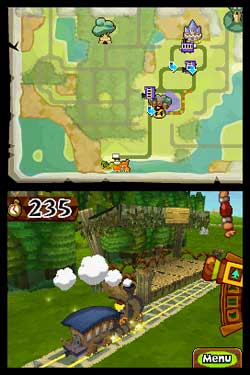
The Spirit Tracks are quickly revealed as the chains used to confine an ancient evil beneath the ground, which is admittedly a clever route. And the very idea of the train is a romantic one, which would seem fit for the themes that run through the series even if it changes our ideas of Hyrule’s pastoral setting. My ideal image of the train involves writing novels and drinking excessively, which are absent here.
Instead the game asks players to ride the rails from one end of Hyrule to the other, blowing the whistle to frighten away monsters, and using the cannon to fend off more determined creatures. To stem any chance of the trip becoming monotonous, players will also take deviations from their planed routes in order to avoid demon trains that travel fixed paths in certain areas. There’s even the ability to trace the route of travel before departing, allowing the train to handle rail-switches and providing plenty of time to let the mind drift and perhaps write that novel after all.
But let’s step back for a moment and return to Windwaker, that finest example of carrying the series beyond the blocky but well-executed N64 legacy. It’s a nostalgia trip that requires me to talk about the bond I formed with that boat during key moments where I felt lost or frustrated, finding it my only constant companion while left floating on the open sea. My remembrance of Windwaker is one of initial frustrations in trying to learn a changed landscape, finally resorting to making my own map – something I’d not done since childhood. I did this because in feeling challenged, I felt a greater desire to search every inch of Hyrule out, something that once again feels like the lost habits of childhood. Above all else, Windwaker is about capitalizing on an idea of the trip as part of the experience and an essential building block in the development of Link’s character, and mine as well.
The rewards of meeting and surpassing Windwaker’s challenges made me a better player.
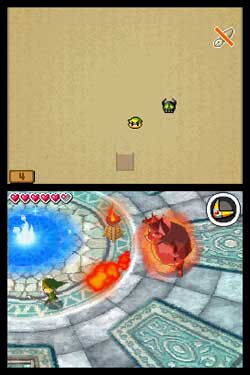
Yet this isn’t about swapping a boat for a train because of my candy colored memories. Rather, this is about what a train represents in comparison, which involves connecting distant locations and building a nation through that connection. I’m not entirely sure how this concept can be properly applied to a videogame, and neither is Nintendo.
What emerges is a game that exploits the device in ways that violate the nobility of the series, offering an easier path toward player gratification by simplifying the spaces between larger conflicts, viewing that separation of space between points as obligatory and tedious rather than as a key area of focus. It’s entirely odd that the trip itself is made so much more exhausting with the landscape reduced to bland repeating patterns of blocky scenery. Again the answer to our boredom is the cannon, which serves as Nintendo’s answer to the mechanized suit of modern games, complete with unlimited ammunition.
The stops along the way spread out like the map from a Final Fantasy title, attempting to uphold an idea of the series with a monotonous rhythm method that sends the player to all points of the map for typical reasons. Let me know if you recognize the equation,
Point X requires Player to travel to Point Y to solve puzzle that sends Player to Point Z to finally learn how to meet the challenge of Point X.
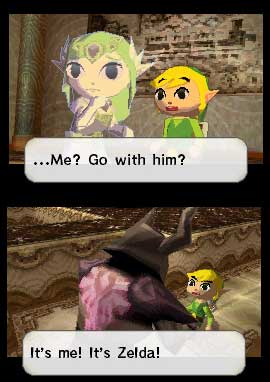
These design deviations run underneath a title that very much possesses Nintendo’s perfected aesthetic of sound and color. Both Zelda and Link are still possessed of more expression and emotion in the simplest facial shift than any 3D uber-budget game to hit the shelves alongside Spirit Tracks. And yet the very reason I’ve appreciated two separate development goals across two systems also adds to the mutation of direction here.
The cell-shaded style takes a strange turn that follows the narrative toward moments of buddy comedy in the amplification of the exaggerated humor those visuals are capable of. Rather than subtle charms found in smaller smiles and wide-eyed surprise, Zelda in particular is given to repeated bouts of drama that sacrifice something precious in her character for the humor of seeing her bust out of a traditional role in a very predictable way.
This approach undermines what Windwaker accomplished in proving that the cell-shaded style could accentuate both classic and mature themes in ways we perhaps hadn’t considered, sinking back into something Nintendo had fiercely resisted with that original deviation from form.
The ease of picking up and playing the game with a few control refinements can’t carry the weight of complaints, particularly when the challenge of battles is more about the player carrying out two contrary acts in the physical world – dear Nintendo, I am starting to resent your microphone obsession.
Spirit Tracks is a sweetly polished train that has no destination, with stopovers that revel in cell-shaded antics more than the legacy inherent in the title. Even if you’re desperate for another trip to Hyrule, consider this candy rather than a full and proper meal. Call it candy-Zelda or even Zelda-lite if you want, not because of the system it appears on, but rather because of how light this release is on the fulfilling substance the series is cherished for.
The Legend of Zelda: Spirit Tracks
Developer – Nintendo EAD
Publisher – Nintendo
System – Nintendo DS
Release Date – December 7, 2009
*A copy of this title was provided by the publisher for review